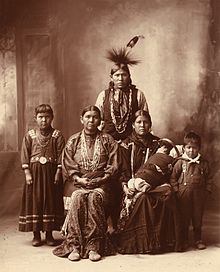
Back Familie (verwantskap) Afrikaans Familie ALS ቤተሠብ Amharic Familia AN أسرة Arabic عيله ARZ পৰিয়াল Assamese Familia AST Wila masi Aymara Ailə Azerbaijani
| Part of a series on the |
| Anthropology of kinship |
|---|
 |
|
Social anthropology Cultural anthropology |

Family (from Latin: familia) is a group of people related either by consanguinity (by recognized birth) or affinity (by marriage or other relationship). It forms the basis for social order.[1] Ideally, families offer predictability, structure, and safety as members mature and learn to participate in the community.[2] Historically, most human societies use family as the primary purpose of attachment, nurturance, and socialization.[3][4][5][6]
Anthropologists classify most family organizations as matrifocal (a mother and her children), patrifocal (a father and his children), conjugal (a married couple with children, also called the nuclear family), avuncular (a man, his sister, and her children), or extended (in addition to parents, spouse and children, may include grandparents, aunts, uncles, or cousins).
The field of genealogy aims to trace family lineages through history. The family is also an important economic unit studied in family economics. The word "families" can be used metaphorically to create more inclusive categories such as community, nationhood, and global village.
- ^ Brown, Roy I.; Brown, Ivan (2014). "Family Quality of Life". Encyclopedia of Quality of Life and Well-Being Research. Dordrecht: Springer Netherlands. pp. 2194–2201. doi:10.1007/978-94-007-0753-5_1006. ISBN 978-94-007-0752-8.
family is recognized in cultures around the world and across history as a fundamental unit of social order.
- ^ Donald Collins; Catheleen Jordan; Heather Coleman (2010). An Introduction to Family Social Work. Brooks/Cole, Cengage Learning. pp. 28–29. ISBN 978-0-495-80872-5. Archived from the original on 2020-07-31. Retrieved 2019-08-13.
- ^ Alhussain, Khalid, Shah, Drishti, Thornton, James, Kelly, Kimberly. Familial Opioid Misuse and Family Cohesion: Impact on Family Communication and Well-being. Addictive Disorders & Their Treatment 2019;18(4):194–204. doi:10.1097/ADT.0000000000000165.
- ^ Lander L, Howsare J, Byrne M. The impact of substance use disorders on families and children: from theory to practice. Soc Work Public Health. 2013;28:194–205.
- ^ Manzi, Claudia; Brambilla, Maria (2014). "Family Connectedness". Encyclopedia of Quality of Life and Well-Being Research. Dordrecht: Springer Netherlands. pp. 2167–2168. doi:10.1007/978-94-007-0753-5_998. ISBN 978-94-007-0752-8.
Family connectedness is defined as a particular characteristic of the family bond, also referred as family or parental closeness, support, warmth, or responsiveness. This characteristic of the family can be observed when families maintain emotional connections with each other through encouragement of shared family celebrations, family rituals, and family traditions.
- ^ de Jong, D.C.; Reis, H.T. (2016). "Love and Intimacy". Encyclopedia of Mental Health. Elsevier. pp. 25–32. doi:10.1016/b978-0-12-397045-9.00107-5. ISBN 9780123977533.
Central to intimacy is responsiveness, the process by which relationship partners attend to and respond supportively to each other's wishes, needs, and concerns. Responsive interactions begin when one person discloses a core aspect of his or her self.